Scottish farm business income: annual estimates 2013-2014
This publication contains farm business level estimates of average incomes for the accounting year 2013-14, relating to the 2013 crop year. For the most recent data, visit the Scottish farm business income (FBI) collection page below.
This document is part of a collection
7. Sector Results
7.1 Specialist Sheep (LFA) Farms - 2013-14 Crop Year
Profitability
Accounting for inflation, between 2009-10 and 2013-14, the average FBI of specialist sheep (LFA) farms decreased by around 26 per cent. This decrease was due to a rise in input costs, especially labour and livestock and a fall in livestock output value.
In the last year both input costs and output value for specialist sheep (LFA) farms have increased, resulting in an overall increase in profits for 2013-14. The average value of grants and subsidies remained largely unchanged to leave the FBI value of specialist sheep (LFA) farms at £24,000.
Return to unpaid labour
The average FBI/FTE for specialist sheep (LFA) farms of £20,000 is roughly equivalent to an hourly wage for unpaid labour of £10.53, one and a half times the minimum agricultural wage in Scotland. Around 66 per cent of specialist sheep (LFA) farms generated incomes equivalent to less than the minimum agricultural wage (MAW), whereas 12 per cent generated more than five times MAW.
Relative performance
At £204,000, on average, high performing specialist sheep farms generated incomes roughly eight times the overall average. This in part is due to a small number of specialist sheep (LFA) farms engaging in miscellaneous agricultural activities not related to sheep production. Low performing farm businesses made an average loss of -£15,000.
Drivers of profitability
The total average outputs, (including income from diversification and grants and subsides) and inputs for specialist sheep (LFA) farms were £99,000 and £75,000 respectively. The largest portion of the input costs were due to other inputs such as machinery and land and buildings costs.
Over the last five years, FBI without subsidies has been below zero. An increase was observed in 2011-12 but income has since decreased. It ranges from -£8,000 in 2009-10 to -£16,000 in 2012-13. In 2013-14 the average FBI without subsidies of specialist sheep (LFA) was -£13,000.
Trends in cost centres for specialist sheep (LFA) farms show an overall increase, over the last year, improvements in income from agricultural and agri-environmental activities as well as diversification over the last year, with a decrease observed for contracting activities and subsides.
Financial strength
The average net worth (assets minus liabilities) of specialist sheep (LFA) farms was £645,000 in 2013-14. The average debt ratio (liabilities: assets) was seven per cent overall but ranged between four per cent for owner-occupied and tenanted farms and 18 per cent for mixed tenure farms.
Specialist sheep (LFA) Farms - FBI (2013-14): £24,000
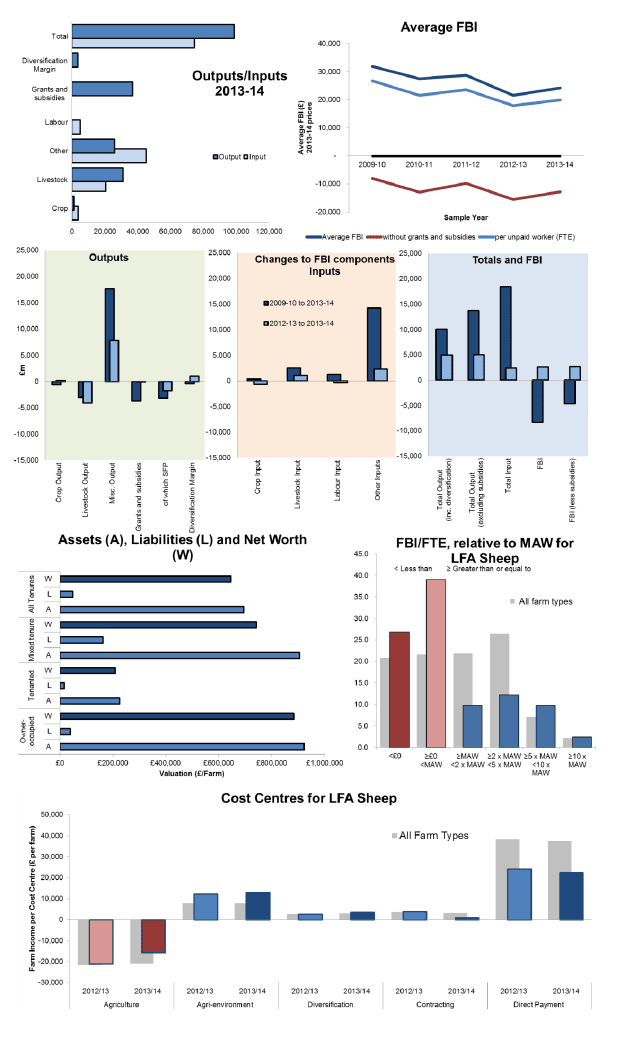
7.2 Specialist Cattle (LFA) Farms - 2013-14 Crop Year
Profitability
Accounting for inflation, between 2009-10 and 2013-14 the average FBI of specialist cattle (LFA) farms decreased by around 49 per cent, to the lowest level in five years. This decrease was due to a rise in input costs, especially livestock and crop and a fall in subsides.
In the last year input costs and output value for specialist cattle (LFA) farms have both increased, resulting in an overall decline in profits for 2013-14. The average value of grants and subsidies increased (up £400) to leave the FBI value of specialist cattle (LFA) farms at £25,000.
Return to unpaid labour
The average FBI/FTE for specialist cattle farms of £17,000 is roughly equivalent to an hourly wage for unpaid labour of £8.82, just under one and a half times the minimum agricultural wage in Scotland. Around 39 per cent of specialist cattle (LFA) farms generated incomes equivalent to less than the minimum agricultural wage (MAW) whereas six per cent generated more than five times MAW.
Relative performance
At £63,000, on average, high performing specialist cattle (LFA) farms generated incomes more than twice the overall average. Low performing farm businesses made an average loss of -£16,000.
Drivers of profitability
The total average outputs, (including income from diversification and grants and subsides) and inputs for specialist cattle (LFA) farms were £185,000 and £160,000 respectively. The largest portion of the input costs was due to feed and other inputs such as machinery, land and buildings.
Over the last five years, FBI without subsidies has been below zero ranging from -£10,000 in 2009-10 to -£30,000 in 2013-14.
Trends in cost centres for specialist cattle (LFA) farms show an overall decrease in income from agricultural activities compared to 2012-13, costs remained steady for diversification, contracting, subsides and agri-environmental activities.
Financial strength
The average net worth (assets minus liabilities) of specialist cattle (LFA) farms was £1m in 2013-14. The average debt ratio (liabilities: assets) was ten per cent for all tenures of specialist cattle (LFA) farms but ranged between ten per cent for owner-occupied and 13 per cent for tenanted farms.
Specialist Cattle Farms (LFA) - FBI (2013-14): £25,000
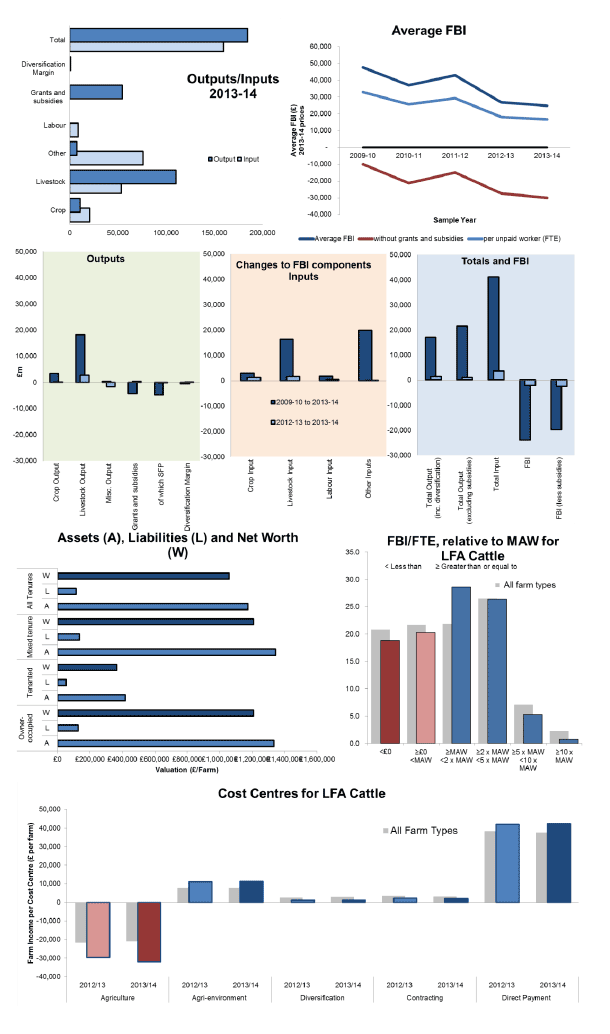
7.3 Specialist cattle and sheep (LFA) Farms - 2013-14 Crop Year
Profitability
Accounting for inflation, between 2009-10 and 2013-14 the average FBI of specialist cattle and sheep (LFA) farms decreased by around 43 per cent. This decrease was due to a rise in input costs, especially labour and livestock and a fall in the value of subsides and reduced margins from diversification.
In the last year input costs for specialist cattle and sheep (LFA) farms have slightly increased, while the output value had a greater increase, this combined with an average increase in the value of grants and subsidies (up £2,000) produced a FBI value of specialist cattle and sheep (LFA) farms at £26,000.
Return to unpaid labour
The average FBI/FTE for specialist cattle and sheep (LFA) of £16,000 is roughly equivalent to an hourly wage for unpaid labour of £8.38, almost equivalent to one and a half times the minimum agricultural wage in Scotland. Around 47 per cent of specialist cattle and sheep (LFA) farms generated incomes equivalent to less than the minimum agricultural wage (MAW), whereas two per cent generated more than five times MAW.
Relative performance
At £66,000, on average, high performing specialist cattle and sheep (LFA) farms generated incomes roughly two and a half times the overall average. Low performing farm businesses made an average loss of -£18,000.
Drivers of profitability
The total average outputs, (including income from diversification and grants and subsides) and inputs for specialist cattle and sheep (LFA) farms were £172,000 and £146,000 respectively. The largest portion of the input costs was due to feed and other inputs such as machinery, land and buildings.
Over the last five years, FBI without subsidies has been below zero and declining. It ranges from -£19,000 in 2009-10 to -£36,000 in 2012-13. In 2013-14 the average FBI without subsidies of specialist cattle and sheep (LFA) was -£34,000.
Trends in cost centres for specialist cattle and sheep (LFA) farms are showing an overall increase in income as part of diversification and contracting compared to 2012-13, with income from agricultural and environmental activities and subsides remaining largely unchanged.
Financial strength
The average net worth (assets minus liabilities) of specialist cattle and sheep (LFA) farms was £992,000 in 2013-14. The average debt ratio (liabilities: assets) was 12 per cent for all tenures of LFA cattle and sheep farms but ranged between 11 per cent for owner-occupied and 18 per cent for tenanted farms.
Specialist Cattle and Sheep Farms (LFA) - FBI (2013-14): £26,000
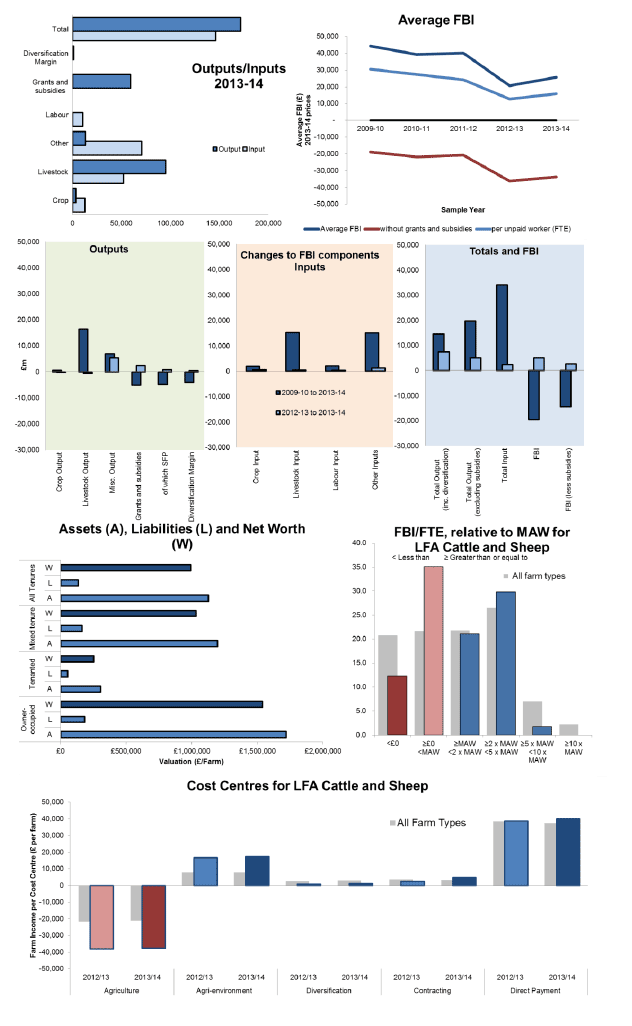
7.4 Cereal Farms - 2013-14 Crop Year
Profitability
Accounting for inflation, between 2009-10 and 2013-14 the average FBI of cereal farms decreased by around 16 per cent. This was due to an increase in input costs for crops and land and buildings.
In the last year both input and output values for cereal farms have decreased, this combined with an average decrease in the value of grants and subsidies (down £5,000) resulting in an overall decrease in income for 2013-14 to leave the FBI value of cereal farms at £23,000.
Return to unpaid labour
The average FBI/FTE for cereal farms of £18,000 is roughly equivalent to an hourly wage for unpaid labour of £9.42, almost equivalent to one and a half times the minimum agricultural wage in Scotland. Around 46 per cent of cereal farms generated incomes equivalent to less than the minimum agricultural wage (MAW), whereas 15 per cent generated more than five times MAW.
Relative performance
At £75,000, on average, high performing cereal farms generated incomes roughly three times the overall average. Low performing farm businesses made an average loss of -£22,000.
Drivers of profitability
The total average outputs, (including income from diversification and grants and subsides) and inputs for cereal farms were and £223,000 and £200,000 respectively. The largest portion of the input costs was due to other inputs such as machinery, land and buildings.
Over the last five years, FBI without subsidies has been below zero three times, ranging from -£21,000 in 2012-13 to £16,000 in 2011-12. In 2013-14 the average FBI without subsidies of cereal farms was -£17,000.
Trends in cost centres for cereal farms are showing a slight overall decrease in income as part of environmental activities, contracting and subsides compared to 2012-13. Income from agricultural and diversified activities improved in 2013-14.
Financial strength
The average net worth (assets minus liabilities) of cereal farms was £1.9m in 2013-14. The average debt ratio (liabilities: assets) was seven per cent for all tenures of cereals farms but ranged between seven per cent for owner-occupied and 21 per cent for tenanted farms.
Cereals Farms - FBI (2013-14): £23,000
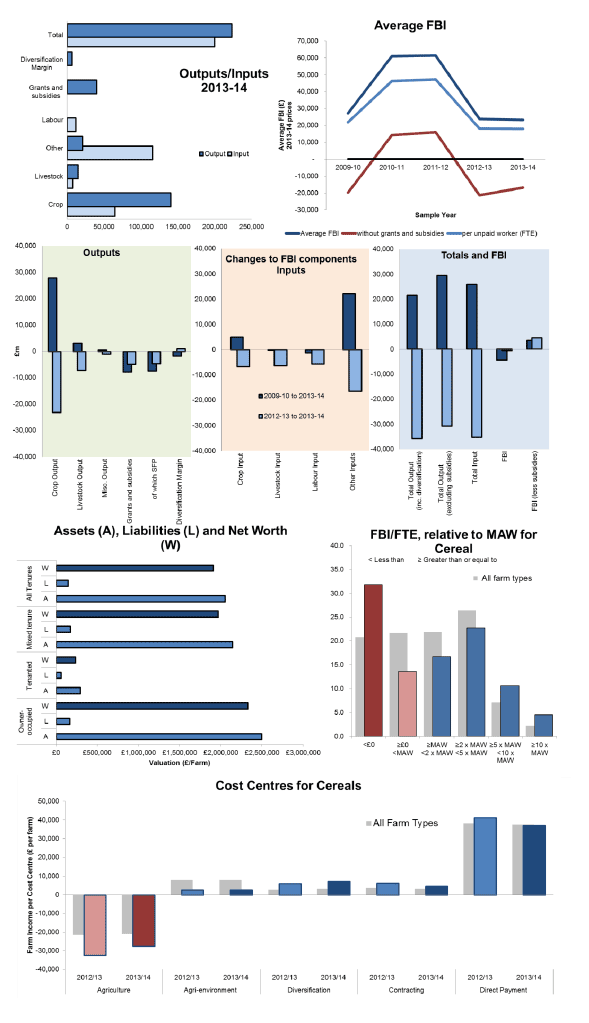
7.5 General Cropping Farms - 2013-14 Crop Year
Profitability
Accounting for inflation, between 2009-10 and 2013-14 the average FBI of general cropping farms increased by around 33 per cent. This was due to an increase in the output value of crops and fall in the crop and labour input costs.
In the last year both input and output values for general cropping farms have decreased, this combined with an average decrease in the value of grants and subsidies (down £3,000) has resulted in an overall decrease in income for 2013-14 to leave the FBI value of general cropping farms at £36,000.
Return to unpaid labour
The average FBI/FTE for general cropping farms of £26,000 is roughly equivalent to an hourly wage for unpaid labour of £13.81, almost equivalent to twice the minimum agricultural wage in Scotland. Around 40 per cent of general cropping farms generated incomes equivalent to less than the minimum agricultural wage (MAW) whereas 15 per cent generated more than 10 times MAW.
Relative performance
At £95,000, on average, high performing general cropping farms generated incomes roughly three times the overall average. Low performing farm businesses made a loss with an average income of -£8,000.
Drivers of profitability
The total average outputs, (including income from diversification and grants and subsides) and inputs for general cropping farms were £267,000 and £231,000 respectively. The largest portion of the input costs was due to fertiliser and other inputs such as machinery, land and buildings.
Over the last five years, FBI without subsidies has been below zero twice, ranging from -£21,000 in 2009-10 to £28,000 in 2010-11. In 2013-14 the average FBI without subsidies of general cropping farms was -£900.
Trends in cost centres for general cropping farms are showing an overall decrease in income as part of agricultural and environmental activities as well as contracting and subsides compared to 2012-13. Income from diversification increased in 2013-14.
Financial strength
The average net worth (assets minus liabilities) of general cropping farms was £1.9m in 2013-14. The average debt ratio (liabilities: assets) was seven per cent for all tenures of general cropping farms but ranged between six per cent for owner-occupied and 25 per cent for tenanted farms.
General Cropping Farms - FBI (2013-14): £36,000
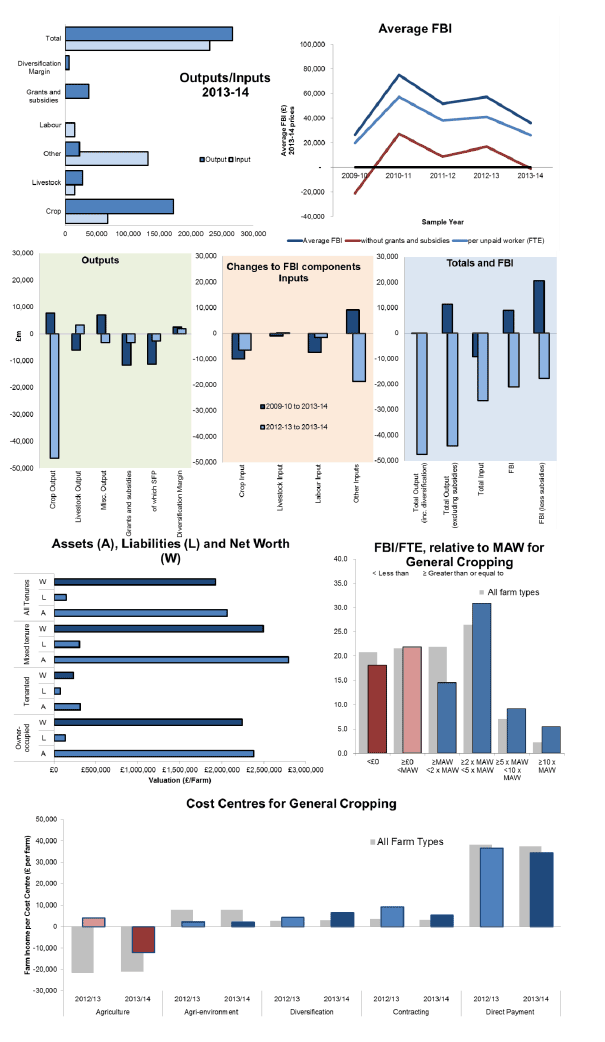
7.6 Dairy Farms - 2013-14 Crop Year
Profitability
Accounting for inflation, between 2009-10 and 2013-14 the average FBI of dairy farms decreased by around six per cent. This was due to an increase in the input costs for livestock and machinery, land and buildings.
In 2013-14 output values for dairy farms (up £67,000 on the previous year) increased by twice as much as the rise in input costs (up £35,000), resulting in an overall increase in income, almost back to levels last seen in 2010-11. Additionally, the average value of grants and subsides has increased (up £2,000) to leave the FBI value of dairy farms at £80,000.
Return to unpaid labour
The average FBI/FTE for dairy farms of £39,000 is roughly equivalent to an hourly wage for unpaid labour of £20.45, almost equivalent to three times the minimum agricultural wage in Scotland. Around 24 per cent of dairy farms generated incomes equivalent to less than the minimum agricultural wage (MAW) whereas 22 per cent generated more than five times MAW.
Relative performance
At £205,000, on average, high performing dairy farms generated incomes more than two times the overall average. Low performing farm businesses made an average loss of -£6,000.
Drivers of profitability
The total average outputs, (including income from diversification and grants and subsides) and inputs for dairy farms were £516,000 and £436,000 respectively. The largest portion of the input costs was due to livestock costs such as feed and other inputs such as machinery, land and buildings.
Over the last five years, FBI without subsidies has been kept above zero. It ranges from £4,000 in 2012-13 to £41,000 in 2011-12. In 2013-14 the average FBI without subsidies of dairy farms was £36,000.
Trends in cost centres for dairy farms are showing an overall increase in income as agricultural activities, contracting and subsides compared to 2012-13, income decreased for environmental activities and diversification.
Financial strength
The average net worth (assets minus liabilities) of dairy farms was £1.8m in 2013-14. The average debt ratio (liabilities: assets) was 14 per cent for all tenures of dairy farms.
Dairy Farms - FBI (2013-14): £80,000
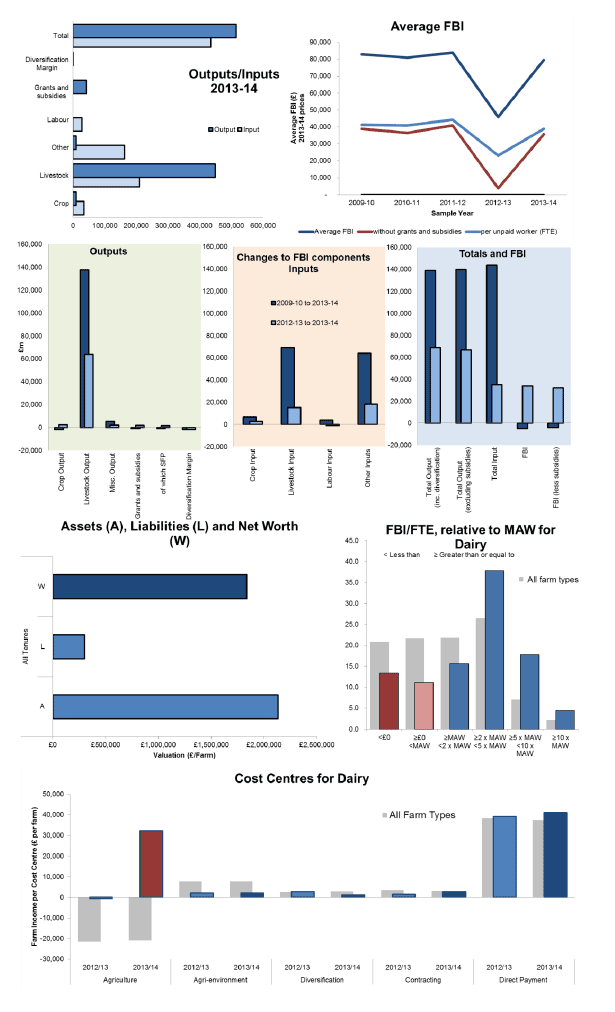
7.7 Lowland Cattle and Sheep Farms - 2013-14 Crop Year
Profitability
Accounting for inflation, between 2009-10 and 2013-14 the average FBI of lowland cattle and sheep farms decreased by around 41 per cent. This was due to an increase in the input costs for livestock and machinery, land and buildings.
In the last year both input costs and output values for lowland cattle and sheep farms have increased, resulting in an overall increase in FBI value for 2013-14. The average value of grants and subsidies has remained unchanged to leave the FBI value of lowland cattle and sheep farms at £24,000.
Return to unpaid labour
The average FBI/FTE for lowland cattle and sheep farms of £17,000 is roughly equivalent to an hourly wage for unpaid labour of £8.78, below the minimum agricultural wage in Scotland. Around 48 per cent of lowland cattle and sheep farms generated incomes equivalent to less than the minimum agricultural wage (MAW) whereas four per cent generated more than five times MAW.
Relative performance
At £76,000, on average, high performing lowland cattle and sheep farms generated incomes roughly three times the overall average. Low performing farm businesses made an average loss of -£14,000.
Drivers of profitability
The total average outputs, (including income from diversification and grants and subsides) and inputs for lowland cattle and sheep farms were £181,000 and £157,000 respectively. The largest portion of the input costs was due to feed and other inputs such as machinery, land and buildings.
Over the last five years, FBI without subsidies has been below zero. It has ranged from -£23,000 in 2012-13 to -£6,000 in 2010-11. In 2013-14 the average FBI without subsidies of lowland cattle and sheep farms was -£18,000.
Trends in cost centres for lowland cattle and sheep farms are showing an overall increase in income as part of agricultural compared to 2012-13, with diversification, contacting, subsides and environmental activities remaining largely unchanged.
Financial strength
The average net worth (assets minus liabilities) of lowland cattle and sheep farms was £1.1m in 2013-14. The average debt ratio (liabilities: assets) was 10 per cent for all tenures of lowland cattle and sheep farms but ranged between eight per cent for owner-occupied and 14 per cent for mixed farms.
Lowland Cattle and Sheep Farms - FBI (2013-14): £24,000
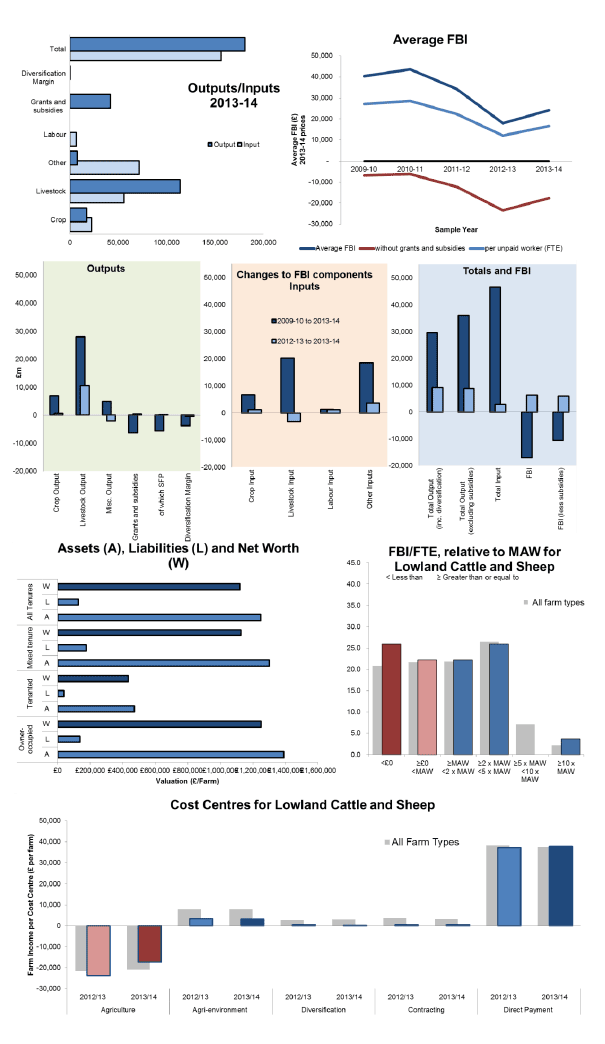
7.8 Mixed Farms - 2013-14 Crop Year
Profitability
Accounting for inflation, between 2009-10 and 2013-14 the average FBI of mixed farms decreased by around 24 per cent. This was due to an increase in the input costs for crop, livestock and machinery, land and buildings.
In the last year both input costs and output values for mixed farms have decreased, resulting in an overall decline in FBI value for 2013-14. The average value of grants and subsidies decreased (down £2,000) to leave the FBI value of mixed farms at £30,000.
Return to unpaid labour
The average FBI/FTE for mixed farms of £18,000 is equivalent to an hourly wage for unpaid labour of £9.31, around one and a half times the minimum agricultural wage in Scotland. Around 39 per cent of mixed farms generated incomes equivalent to less than the minimum agricultural wage (MAW), whereas four per cent generated more than five times MAW.
Relative performance
At £79,000, on average, high performing mixed farms generated incomes roughly two and a half times the overall average. Low performing farm businesses made an average loss of -£13,000.
Drivers of profitability
The total average outputs, (including income from diversification and grants and subsides) and inputs for mixed farms were £275,000 and £245,000 respectively. The largest portion of the input costs was due to other inputs such as machinery, land and buildings.
Over the last five years, FBI without subsidies has been below zero, with the exception of 2010-11 when FBI without subsidies was £96. In other years it ranges from -£23,000 in 2013-14 to -£7,000 in 2011-12.
Trends in cost centres for mixed farms are showing an overall decrease in income as part of agricultural and environmental activities, diversification and subsides compared to 2012-13, an increase was observed for contracting activities in 2013-14.
Financial strength
The average net worth (assets minus liabilities) of mixed farms was £1.7m in 2013-14. The average debt ratio (liabilities: assets) was 11 per cent for all tenures of mixed farms but ranged between nine per cent for owner-occupied farms and 19 per cent for tenanted farms.
Mixed Farms - FBI (2013-14): £30,000
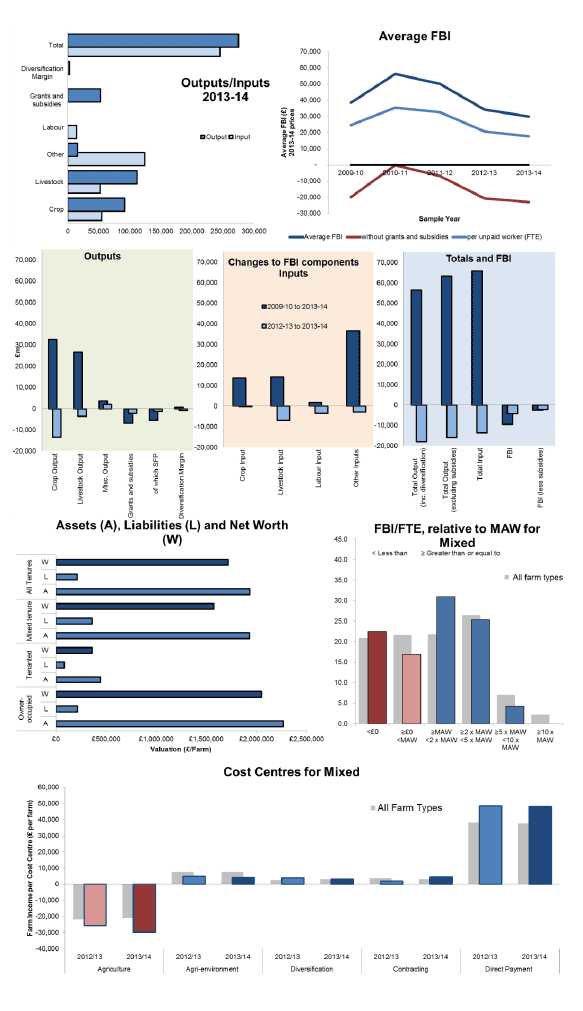
Contact
Email: agric.stats@gov.scot
There is a problem
Thanks for your feedback